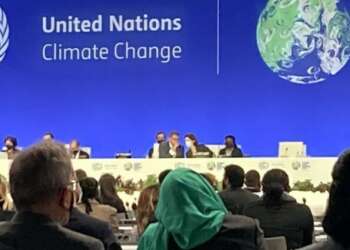
COP President Alok Sharma consults, COP26 Plenary, 12th November 2021
Sitting in the plenary session as an Observer on what was scheduled to be the last day of COP, it soon became apparent that India, China and South Africa were determined to derail the COP President’s plans to secure the ‘the end of coal’ – the most obvious single step in keeping 1.5 alive. Sure enough the conference spilled into Saturday and the wording was changed from “phasing out” to “phasing down” unabated coal, and from phasing out fossil fuel subsidies to phasing out inefficient ones, with no associated deadlines. Such is the way of multilateral negotiations you might say (this one with 197 parties) and COP26 was never going to single-handedly achieve what’s needed to stop dangerous climate change in its tracks. So was COP26 as an abject failure - more blah, blah, blah - or has it left us with a better chance of avoiding a climate catastrophe?
Wind back to 2018; the IPCC’s Special Report on 1.5 degrees in 2018 made it clear that 2°C is not a safe limit, and that we need to cut emissions by 45% (on a 2010 baseline) and hit net zero by 2050 to keep within 1.5°C. But according to the UNEP Emissions Gap Report we were heading for average global temperature rise of 2.7°C even if the national pledges made at COP21 in Paris had been implemented (which they hadn’t). Fast forward to the end of 2021 and that estimate has changed to somewhere between 1.9°C and 2.5°C of heating, depending how optimistic your assumptions; in any case well short of where we need to be.

Earth’s future hangs in the balance, COP26, November 2021
In the end, the Glasgow Climate Pact made moves towards “keeping 1.5 alive,” stating that signatories would “pursue efforts to limit temperature increase to 1.5°C,” including “reducing global carbon dioxide emissions by 45% by 2030… and to net zero around mid-century,” as well as calling for “deep reductions in other greenhouse gases.” But was always going to be wholly unsatisfactory compromise, reflecting vested and short-term political and commercial interests. It could even be argued that since the UNFCCC was established with the aim of “stabilising greenhouse gas concentrations… at a level that will prevent dangerous anthropogenic interference with the climate system,” the UN process itself has repeatedly failed to deliver what it was set up to do. But then what else have we got?
Looking at the positives; one of COP’s key tasks was to raise the ambition of the national targets, the UNFCCC Synthesis Report having concluded in February 2021 that these were not on track to meet the Paris goal. And whilst only about three quarters of countries had submitted their five year updates by the end of the COP, signatories did agree to strengthen their 2030 targets in 2022 (instead of in five years’ time) backed up by proposals for an annual ministerial round table, providing some room for optimism. COP26 also finalised Article 6 of the Paris Agreement (the ‘Paris rulebook’), clarifying rules around carbon markets, which should bolster international cooperation on the nationally determined contributions (NDCs), and investment in new technology. And I’m told this was the first time ‘coal’ and ‘fossil fuels subsidies’ were actually mentioned in a COP agreement, a signal in itself that fossil fuels are on the way out.

Fighting to Keep 1.5 alive. COP President Alok Sharma COP26, Nov. 2021
Developed nations also reaffirmed their commitment to providing $100 billion annually to developing countries (originally pledged at COP15 in Copenhagen, extended at COP21 in Paris, but yet to be fulfilled) and to double finance for climate adaptation by 2025. The pledge also ‘urged’ developed country parties to provide support for “loss and damage” resulting from the current impacts of climate change, though no commitment to funding from the US or EU was forthcoming.
While country delegations made painfully slow progress, towards an inadequate agreement, behind closed doors (which seemed more closed than at previous COPs), it’s what went on around the COP that was noticeably more significant, compared with previous years. This includes everything from an increasingly vociferous civil society, to a much more engaged business sector, to far-reaching initiatives in the financial sector, as well as with a string of agreements and announcements made in parallel with the Conference.
Initiatives alongside the official process included agreement to reverse deforestation by 2030; an agreement to cut methane emissions; a pledge to accelerate adoption of green hydrogen; a cement and steel industry emissions reduction agreement; and the setting up of an International Sustainability Standards Board (ISSB), tasked with introducing global carbon reporting standards. Chancellor Rishi Sunak also announced plans for the UK to become the world’s first net zero aligned financial centre and a Transition Plan Taskforce to support the requirement for UK financial institutions and listed companies to publish net-zero transition plans. There were also commitments announced from coalitions such as the Glasgow Financial Alliance for Net Zero (GFANZ), which brings together 450 institutions from 45 countries to deliver the $100 trillion of finance needed for net zero over the next three decades.
It’s perhaps the wider context in which this COP took place that gives the most room for hope. With the emergence of XR, school strikes, climate emergency declarations and that famous documentary from Sir David Attenborough, all having a significant impact on raising public awareness and dissatisfaction with the way those in power are responding. An estimated 100,000 people marched through Glasgow on the Global Day of Action (6th Nov.), and there was even a protest march inside the Blue Zone (the delegate area of the conference), on the morning of 12th, something I don’t recall happening at previous COPs. More confirmation that the momentum for change has overtaken the UNFCCC event itself, which Greta Thunberg described as a Global North Greenwash Festival.

Steet style protests inside the Blue Zone at COP26, 12th November 2021
I was only in Glasgow for a couple of days at the end of the conference but my abiding memories of COP26 included:
- The People’s Plenary and speeches by indigenous peoples from around the world, followed by the protest march that snaked its way through the conference corridors. Separated from the people on the outside (demanding the same thing) by steel fencing, UN Security Guards on the inside and vans full of police officers on the outside!
- Speeches by national delegations, including the European Commission's Vice President Frans Timmermans and US Climate Envoy John Kerry, in the Friday afternoon Plenary session. These included heartfelt pleas of the Island nations, some of who will be the first disappear as sea level rises. And depressing speeches from Russia, China and India, without whose cooperation the world cannot decarbonise in time. Expertly chaired throughout by a calm and collected COP Present Sharma.
- And after it was all over, the way the politicians quickly moved on, and climate change suddenly stopped being on the lunchtime and evening news, as it had every day for weeks before.

Outside the gates, as delegates departed
COP26 was a global marker and a cross-societal gathering point. We can only hope it also marks an historical turning point. What happens next is of course what matters now. How quickly the world transitions from fossil fuels to clean and renewable sources of energy, modes of transport and means of food production, and reverses the destruction of our carbon sinks and the natural environment. It needs to be quick - according to the World Meteorological Organization (WMO), we are already experiencing a mean temperature rise of 1.11°C - 1.23°C above pre-industrial levels (backed-up by recent EU data) and we could exceed 1.5°C as soon as the mid-2030s, based on the Inter-governmental Panel on Climate Change (IPCC) 6th Assessment Report. Being realistic (but still optimistic), keeping below 2 degrees may be the best we can achieve and even that will require a herculean effort.
Reflecting on COP26, it as clear as it’s ever been that the UNFCCC process, though essential, isn’t going to solve the ‘biggest threat modern humans have ever faced’ on its own. People will need to force the hands of their politicians and themselves to be more acceptant of changes to their way of life, if we’re to overcome it. The question of climate justice and equitable transition are at the heart of it (and of the COP debates). In the meantime, cities, regions, institutions, businesses, communities and individuals, all working hard in spite of governments, need to move up a gear and treat climate change as the emergency it really is. As environmental professionals in both public and private sector organisations, we have more insight and influence than many and we need to use it. The UK retains the COP presidency until November. Let’s make 2022 count.
Please note: the views expressed in this blog are those of the contributing individual, and are not necessarily representative of the views of IEMA or any professional institutions with which IEMA is associated.
Subscribe
Subscribe to IEMA's newsletters to receive timely articles, expert opinions, event announcements, and much more, directly in your inbox.
Posted on 14th January 2022
Written by Dr Nick Murry
Latest Posts
-
IA Outlook Journal Volume 21: Impact Assessment Frontiers Part 2: People, Health and Equality
- 22nd July 2024 -
IEMA responds to Carbon Border Adjustment Mechanism (CBAM) consultation - July 2024
- 19th July 2024 -
The detail and policy action required beyond the King’s Speech
- 19th July 2024 -
Energy and Housing Bills included in the King’s Speech
- 17th July 2024 -
Launch of new resource for conservation technology tools
- 11th July 2024 -
Natural Capital 101: Guide for Sustainability Professionals
- 9th July 2024